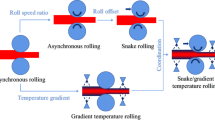Abstract
Based on the volume constancy with equal flow-per-second and elastic sheet stability theory, a coupling relationship among lateral thickness difference, width-to-thickness ratio of cold rolling strip steel under ideal and actual working conditions, and shape is concluded according to the comprehensive influence principle of various factors on the critical instable shape analyzed in-depth. Firstly, the influence model under actual working condition is developed by referring to the basic relationship between lateral thickness difference and shape under ideal condition. The test results prove that for thin strips with thickness below 0.3 mm, their lateral thickness differences have significant effect on the shape. After then, the combined influence of lateral thickness difference and width-to-thickness ratio on the critical instable shape is concluded according to the elastic sheet stability model, with the synthetic effect of these three factors analyzed. Test data indicate that for cold rolling strip steel with width-to-thickness ratio above 3 000, the critical instability stress difference decreases significantly. Actual measurements are conducted on the lateral thickness differences of two rolls of typical strip manufactured by a sixhigh cold mill, with the influence law of lateral thickness variation and width-to-thickness ratio comprehensively investigated. It is demonstrated that during the production of ultrathin strip steel with different width-to-thickness ratios, the loading roll shapes should be fine adjusted according to the lateral thickness difference of input strips. Therefore, the variation of lateral thickness difference of output strips can meet the requirement of shape stability, so as to obtain fine shape.
Similar content being viewed by others
References
DAI J T, ZHANG Q D. Analysis and experiment on central buckling and post buckling of thin cold-rolled sheet [J]. Journal of Mechanical Engineering, 2011, 47(2): 44–50 (in Chinese).
LIU H, YANG Q, HE A R. Influence of speed on ultra thin Aluminum foil rolling [J]. Journal of Plasticity Engineering, 2007, 14(1): 76–79 (in Chinese).
CAO J G, XU X Z, ZHANG J, et al. Preset model of bending force for 6-high reversing cold rolling mill based on genetic algorithm [J]. Journal of Central South University of Technology (English Edition), 2011, 18(5): 1487–1492.
LI R M, YANG L P, YU B Q, et al. Effect of shape detecting roll deflection on original wavefeom signal of cold rolling strip [J]. Iron and Steel, 2013, 48(5): 41–45 (in Chinese).
LI R M, YANG L P, YU B Q, et al. Effect of detection roll installation precision on online shape signal of cold rolling strip [J]. Iron and Steel, 2013, 48(7): 40–48 (in Chinese).
YANG L P, YU B Q, LI R M, et al. Effect of strip edge offset on original shape signal of cold rolling strip [J]. Iron and Steel, 2014, 49(1): 52–56 (in Chinese).
SONG L, SHEN M G, CHEN X B, et al. Optimum control for technology coolant of cold rolling mill [J]. Journal of Liaoning Technical University (Natural Science), 2014, 33(5): 647–650 (in Chinese).
PARK J H, HAN S I, KIM J S. Improvement of shape recognition performance of sendzimir mill control systems using echo state neural networks [J]. Journal of Iron and Steel Research, International, 2014, 21(3): 321–327.
LIU X Y, CUI C Y, CHENG Y W, et al. Shape control technology during electrochemical synthesis of gold nanoparticles [J]. International Journal of Minerals, Metallurgy and Materials, 2013, 20(5): 486–491.
JIANG Z Y, WEI D, TIEU A K. Analysis of cold rolling of ultra thin strip [J]. Journal of Materials Processing Technology, 2009, 209(9): 4584–4589.
LIU H M, YU B Q, YANG L P, et al. Development of cold strip shape meter with entire roll inlayed block intelligence and its industrial application [J]. Iron and Steel, 2011, 46(12): 86–89 (in Chinese).
LIAN J C. Theoretical basis of shape control [J]. Metallurgical Equipment, 1980, 6: 74–89 (in Chinese).
Author information
Authors and Affiliations
Corresponding author
Additional information
Foundation item: the Special Research Fund for the National Major Science and Technology Achievement Transformation Project (No. 2012GG01), the National Natural Science Foundation of China (No. 51305387) and the Provincial Natural Science Foundation of Hebei of China (No. E2015203103)
Rights and permissions
About this article
Cite this article
Song, L., Shen, M., Yang, L. et al. Effect of width-to-thickness ratio and thickness profile changing on the critical instable shape during cold strip rolling. J. Shanghai Jiaotong Univ. (Sci.) 21, 411–418 (2016). https://doi.org/10.1007/s12204-016-1740-1
Received:
Published:
Issue Date:
DOI: https://doi.org/10.1007/s12204-016-1740-1



